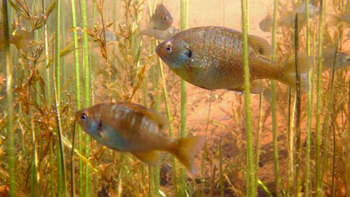When it comes to extremes, biology puts up bigger numbers than the environment

Lepomis macrochirus.
Photo courtesy of Gretchen Hansen
Floods and fires are examples of extreme events in the environment that have negative consequences for humans. As a result, we usually think of plant and animal populations as trying to mitigate the negative impacts of environmental fluctuations. Less often considered is the role that biological populations might play in generating their own extreme events. We found that biological populations have a tendency to amplify environmental variation, producing bigger, more frequent extremes than their surrounding environment. The result has implications for our perception of ecosystem stability, and suggests that when it comes to biological populations, we should expect the unexpected.
See the UW-Madison Press ReleaseSee the Paper DOI (abstract)
April 2017


